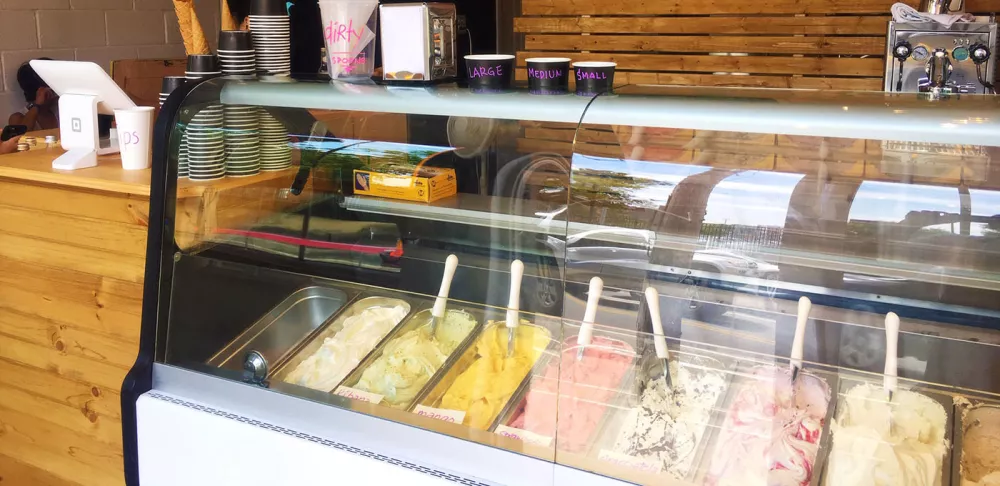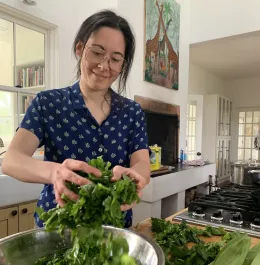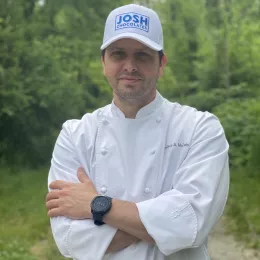Ice cream and summer are a ubiquitous pair. Just thinking about hot weather conjures an image of a creamy scoop melting down its cone. And while there will always be a special, nostalgic place in our hearts for sugary ice cream bars served from a white truck playing music, ICE alumni are employing their talents to take frozen desserts to the next level. From local ingredients and imaginative flavors to skilled techniques, these chefs are redefining summer treats.
While the specific origins of ice cream are unknown, evidence of iced desserts dates back to as early as 500 B.C. in Persia, when ice was flavored with ingredients like rosewater to create a cold sweet. The Roman Emperor Nero, who reigned from 54-68 A.D., is believed to have sent slaves into the mountains to fetch snow to mix with fruit, nectar and honey. Over 1,000 years later, Marco Polo brought to Italy a recipe similar to modern-day sherbet that he picked up throughout his travels in the Far East.
The concept either spread to or developed independently in England and France throughout the 16th and 17th centuries and was brought to America by 1744, when a guest of Maryland Governor William Bladen wrote about tasting the dish. Founding Fathers who enjoyed ice cream include Benjamin Franklin, Thomas Jefferson and George Washington, who reportedly spent $200 on ice cream during the summer of 1790. President Jefferson had an 18-step recipe for the dessert, which was then accessible only to the elite.
Ice cream became more widely available in the late 19th century, ushering in the emergence of the ice cream parlour and soda fountain, quintessential cultural phenomena of the 20th century. The 20th century also brought the invention of soft serve and iconic brands like Baskin-Robbins, Dairy Queen, Ben & Jerry’s and more.
Now, it doesn’t seem like summer without ice cream to keep us cool and satisfied. No one knows that better than Kitty Travers (Culinary, ‘03), who established La Grotta Ices in London in 2008. Kitty and her team sell ice cream flavors that change weekly from the back of a small, white Piaggio Ape, the same vehicle used to sell fruits and vegetables from the farm in Neapolitan markets.
“The intent is to create inventive ice creams that mirror the bright flavor of an exquisite, ripe fruit, but with an almost supernaturally smooth and sublime texture,” Kitty explains. “We focus on using minimally processed, whole ingredients.”
The result is a menu that celebrates seasonal produce in its prime, with flavors like pea pod and cucumber, fresh peach, fig leaf and raspberry sorbet, and green walnut. This summer, La Grotta is scooping Corsican pink grapefruit sorbet flavored with citrus and housemade maraschino cherry syrup created with Montmorency cherries from Kent.
“It’s so refreshing and so plucky,” Kitty says.
While Londoners can also find tubs of La Grotta around the city, we Americans can try our hand at recreating Kitty’s ice creams across the pond with her new cookbook.
Back in the states, Peter Jose (Culinary, ’04) is making gelato magic in Jersey City. He opened Jersey & Co. Gelato in 2015 after finding inspiration in a small resort town in Southern Italy called Reggio Calabria. While he originally went to learn about regional Italian cooking, he left with the desire to study gelato, which he pursued in Northern Italy a year later.
“I love the challenge of precision and accuracy needed to make gelato,” Peter says. “Like in baking, chemistry and precision play a vital role in the production of frozen desserts.”
He’s putting his skills to the test this summer with Jersey & Co.’s Flavors Around the World series that introduces a new internationally driven flavor each week based on customer nominations. The first flavor on the docket is dulce de leche, which was pioneered in Argentina. While not frozen, another refreshing summer offering on the menu is Peter’s Calamansi Spritzer, a carbonated drink topped with calamansi espuma.
“The idea of this came from my Filipino heritage, using techniques I learned from Chef Chris’ hydrocolloids class at ICE and my kitchen experience at The Musket Room. Calamansi is the Philippine lime and the drink is sort of the Philippine version of lemonade,” Peter explains.
In the world of restaurants, frozen desserts are a welcome, sweet ending to a meal. As a pastry cook at The Nomad in New York City, Daniela Vitar (Culinary, ‘18) is working on a menu of five desserts, each featuring a frozen element.
The two iconic desserts that always appear on the menu are Milk and Honey, a honey-oat shortbread, brittle and milk ice cream dish, and Coffee, a granita with crema and vanilla ice cream, which is Daniela’s favorite. Summer sweets include Apricot, a sabayon with apricot sorbet and bitter almonds; Chocolate, a mousse with chocolate yogurt cremeux; and Rice Pudding with blueberries and lemon shaved ice.
“It reminds me of my childhood when I ate arroz con leche, one of my favorite Chilean desserts,” Daniela says. “I like the way you can combine all the elements at once in the spoon.”
She also loves that the menu changes seasonally, allowing her the opportunity to learn new techniques, flavors and combinations that surprise. When it comes to frozen sweets, the science is key.
“My favorite part is to see how the elements transform, and the chemistry behind when you make an ice cream,” Daniela says. “All elements play a role in the frozen process, from flavor to texture. I like when you feel the frozen dessert as something creamy, soft and refreshing on your palate.”
Whether masterfully plated at a storied restaurant or scooped into a cone outdoors, frozen desserts have come a long way with each new generation of chefs.
Pursue a career crafting seasonal desserts with Pastry & Baking Arts training.




